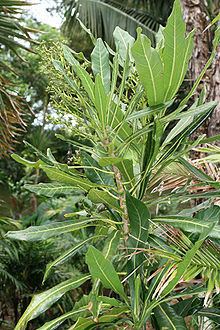Rank Species | Subfamily Aralioideae Scientific name Meryta latifolia | |
 | ||
Similar Achyranthes arborescens, Calystegia affinis, Streblus pendulinus, Meryta denhamii, Hibiscus insularis | ||
Meryta latifolia (Seemann) is an evergreen tree endemic to Norfolk Island, Australia, where it occurs in subtropical moist forest conditions. Its common name is broad-leaved meryta.
Contents
Description
Meryta latifolia is a tree 5–6 m tall, with single trunk or with few branches towards top, with brittle wood. The leaves are broadly oblanceolate, 50 to 75 cm long, 25 to 30 cm broad, gradually narrowed and finally rounded at base, obtuse to rounded at apex. The female inflorescence is terminal, paniculate, 10 to 15 cm long, and densely clustered. The fruit is round, 5 to 6 mm long, bluntly 5 or 6-ribbed.
Convicts apparently used the large leaves to wrap up dough to bake in ashes.
Distribution and status
M. latifolia occurs only on Norfolk Island, and is considered critically endangered because it is dioecious, having separate male and female plants. The total number of mature individual plants is less than 150, the effective reproductive population limited by the number of surviving female plants, which number approximately 20. It occurs on ten sites on Norfolk Island, but most of these contain only one or two plants and only one site has more than 13. Although one site contains approximately 115 trees, regeneration is not occurring at this site. Continuing declines in the number of mature individuals, and number of locations and subpopulations are projected for several reasons including: lack of formal protection or management programs, the vulnerability of small populations to stochastic disturbance events (e.g. cyclones), ongoing competition with invasive weeds, predation by rats, senescence of over-mature plants, and sex ratio bias. The species is adapted to moist forest conditions and is therefore susceptible to unfavourable climate change (projected increases in the incidence of drought and extreme rainfall events that cause physical damage).
Cultivation
Rare in cultivation, M. latifolia may be grown fairly easily in warm frost-free climates like those of Sydney, Australia, or Florida in the United States. A slightly hardier alternative is the New Zealand Puka tree, M. sinclairii, with huge broad leaves, which can withstand frosts down to -2C once established.
